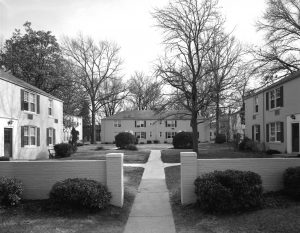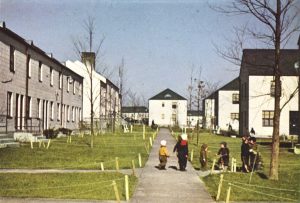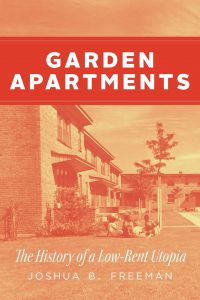Five Questions for Joshua B. Freeman, Author of “Garden Apartments”
In his new book, eminent historian Joshua B. Freeman turns his attention to an overlooked feature of the American landscape: garden apartments. He details their outsized influence on housing and social policy, helping improve living standards for working people. Inspired by the architectural innovations and socialist politics of British garden cities, Red Vienna, and German modernist housing in the 1920s, these large, centrally managed projects were mostly not public housing, but their capitalist developers worked with governments to keep down rents. The results were often relatively small apartments and large communal spaces, aimed at fostering an actual American community. Garden Apartments: The History of a Low-Rent Utopia explores how a form of multifamily housing with idealistic roots became a ubiquitous model promoted by both public entities and private developers. Below, Freeman answers questions about these apartments—what they were like and what we can learn from them.
What are garden apartments, and why haven’t most people heard of them?

Figure 3.9. Children at play in Greenhills, Ohio. John Vachon, Library of Congress, Prints & Photographs Division, FSA/OWI Collection, LC-DIG-fsa-8a05184.
Garden apartments are residential developments, usually of simple two- or three-story buildings, with access through shared entranceways rather than internal public hallways, set on large, landscaped sites, aimed at low- or moderate-income families. Commonly, buildings are made of red brick, arrayed around courtyards, with cars restricted to site perimeters (though some garden apartments, especially in California, have more modernist designs). Most were erected during the 1930s, ’40s, or ’50s, some as privately-owned rental housing, some as government-owned public housing, and some as tenant-owned cooperatives.
Though garden apartments have provided decent dwellings for millions of American families, many people are unfamiliar with them, and they rarely appear in histories of architecture, housing, or urban life. Most garden apartments are in urban areas, so that suburban residents, particularly in newer parts of the country, may not have seen them. Even those who live close to garden apartments may pay little attention to them, because most are architecturally undistinguished. Also, garden apartments do not fit into the common popular and scholarly narratives of American housing, which focus on individual owner-occupied homes, or, in the case of public housing, on big city high-rises. So, this largely successful experiment in affordable housing hides in plain sight. But not to the many, many people who live in or have lived in garden apartments, often to their great satisfaction.

Why do you call garden apartments a “low-rent utopia”?
For most people who moved into a garden apartment, the experience was one of immediate, substantial improvement in daily life. Many had been living in run-down, overcrowded tenements, rural shacks, or post-World War II temporary housing, lacking basic amenities that we now take for granted, like private indoor toilets, central heating, and gas or electric appliances. Garden apartments provided adequate living space, plenty of light and ventilation, modern kitchens and bathrooms, and, what, for most of history, had been a privilege of the rich, privacy. Add to that safe play areas for children, lawns and trees to enjoy and look out at, and public facilities like playgrounds, laundry rooms, and community centers, and the rich sense of community they fostered, and it is easy to understand why, for many families of limited means, their new homes seemed like a kind of utopia.
What was it like to live in a garden apartment? Why do so many people have very fond memories of living in them?
Among adults who lived in garden apartments, a sense of community comes to the fore in their recollections. Garden apartments were designed to foster just that, with shared courtyards and facilities that brought families together and provided plenty of green space for socializing and play. Also, in their early days, garden apartments were typically inhabited mostly by young families, living in new neighborhoods, bonding over shared experiences. Families could turn to one another for help when they needed it. For children, garden apartments meant the freedom to roam. Designed to keep cars away from living areas, garden apartments had courtyards and playgrounds where children could safely play on their own, finding friends and companions by just stepping outside their door.
Not all garden apartment experiences were positive. Over time, some garden apartments, especially those that were government-owned, suffered from deterioration, neglect, and crime. But overall, garden apartments generally proved a very positive experience, both for those for whom they were a waystation toward homeownership and for those for whom they were a long-term solution to affordable housing.
You are a labor historian—what led you to write about garden apartments?
I have always been interested in worker housing, an important, if understudied, part of labor history. But what brought me to garden apartments was my years teaching at Queens College, in New York City, on a campus with garden apartments along one of its sides and more nearby. For a long time, I took the homes I so frequently passed for granted; I had grown up in garden apartments until the age of nine, and through high school, many of my friends had lived in them. But one day, walking to a bus stop to get myself home, I began wondering why there were so many garden apartments in Queens. Who built them? Why do they all look so similar? And why did they stop being built? Only then did it occur to me that garden apartments had a history, and I had no idea what it was. As I began looking more closely, I noticed that the nearby garden apartments were in good repair, well-kept and functional, even though they were well over sixty years old. Living in a city, plagued by insufficient, exorbitantly expensive housing, it belatedly occurred to me that one solution to the problem of affordable housing had been there all along, right in front of my eyes. Garden apartments had been, and still were, a source of decent, attractive housing for people of limited means. Out of those moments, this book originated.

Can garden apartments help us solve the housing crisis that grips so much of the United States?
Conditions today are different from they were in the 1930s, ’40s, and ’50s, when most of the housing discussed in my book was built. Land, especially in urban areas, is harder to find and more expensive than it once was; other costs have shot up, and government support for affordable housing is much diminished. We cannot and should not just copy what earlier generations did. But the basic idea behind garden apartments—that it is possible to build decent, affordable housing for ordinary people, that provides them with space, light, air, and greenery, and which balances privacy with community—seems as important today as ever. If we have the social and political will to do it, architects, planners, and developers could use garden apartments as an inspiration for creating decent, affordable housing that takes advantage of all the technological and design innovations of recent decades. Most importantly, garden apartments illustrate that it is possible to at least make some headway in solving seemingly intractable social problems, including housing the American people.
Joshua B. Freeman is distinguished professor of history emeritus at Queens College and the Graduate Center, City University of New York. He is the author of American Empire: The Rise of a Global Power, the Democratic Revolution at Home, 1945–2000; Behemoth: A History of the Factory and the Making of the Modern World; and Working-Class New York: Life and Labor Since World War II.
Garden Apartments is available now. Use the code UCPNEW to take 30% off at checkout when you order from our website.
